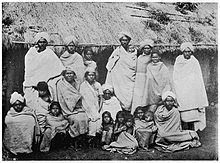Badagas
This article includes a list of general references, but it lacks sufficient corresponding inline citations. (November 2017) |
 Badaga family in the Nilgiri Hills, 1909 | |
| Languages | |
|---|---|
| Badaga |
The Badugas are the peoples living in the Nilgiri district in Tamil Nadu, India. Throughout the district the Badugas live in nearly 400 villages, called Hattis. Baduga people speak the language called "Badugu". The language has no script
Culture
Thundu (a white piece of cloth) and Seeley forms an integral part of the attire of the Badugu women.
Badugas marry within their community and follow their own marriage traditions. Their important festival is Devva Habba. Devva Habba provides significant insights into the origin of Badugas. They have certain rules and regulations to be followed in implementing their cultural rituals from the birth of a child and follows through functions like puberty, marriage, naming ceremony, seventh-month pregnancy, housewarming, and finally in death.
Language
The Badaga language is not a dialect of Kannada, although it is closely related. The Baduga community was formed in the Nilgiris out of small groups that banded together. LACITO in Paris houses numerous varieties of Baduga stories and songs collected over the past two decades.[1]
Education
Several Badaga have become officials in various parts of the Indian Government. Former Lok Sabha MP, the late Smt. Akkamma Devi, was the first Badaga woman to graduate from college and represented the Nilgiri Lok Sabha constituency from 1962 to 1967. Belli Lakshmi Ramakrishnan M.A., was the first Badaga woman post graduate in social work, and went on to be the first woman gazetted officer to serve in the Tamil Nadu State Government Department of Health and Family Welfare.[citation needed]
Scheduled Tribe Status
There is a long-standing demand to restore the status of the Badagas in the list of Scheduled Tribes under the Indian Constitution. The Badagas were on the tribes list during the British Raj, as per the 1931 census. After Independence, Badugas were on the Scheduled Tribe list during the 1951 census, but were later removed.[2]
References
- ^ "Badaga language not a dialect of Kannada, claims French linguistic scholar". Times of India. Retrieved 20 March 2018.
- ^ "Include Badagas in ST list: Jayalalithaa requests PM". The Hindu. Special Correspondent. 2011-07-30. ISSN 0971-751X. Retrieved 2017-12-08.
{{cite news}}: CS1 maint: others (link)
Bibliography
- Gazetteer of India by B.L.Rice, 1877.
- Mysore,Canara and Malabar by Buchanan in 1807
- Madras District Gazateer (The Nilgiris) by W.Francis, 1908
- Mysore,Canara and Malabar by Buchanan in 1807
- Letters on the Climate, inhabitants, Production etc., South India by James Hough, 1826
- Breeks, J.W. (1873), An Account of the Primitive Tribes of the Nilgiris; Nilgiri Manual, vol. i. pp. 218–228; Madras Journ. of Sci. and Lit. vol. viii. pp. 103–105; Madras Museum Bulletin, vol. ii., no. i, pp. 1–7.
- Hockings, P. (1988). Counsel from the ancients, a study of Badaga proverbs, prayers, omens and curses. Berlin and New York: Mouton de Gruyter.
- Hockings, P. (1989). "The cultural ecology of the Nilgiris District" In P. Hockings (Ed.), Blue Mountains: The ethnography and biogeography of a South *Indian region (pp. 360–376). New Delhi and New York: Oxford University Press.
- Hockings, P. (1999). Kindreds of the earth: Badaga household structure and demography. New Delhi and Thousand Oaks, CA: Sage.
- Hockings, P. (2001). "Mortuary ritual of the Badagas of Southern India". (Fieldiana, Anthropology, n.s., 32.) Chicago: Field Museum of Natural History.
